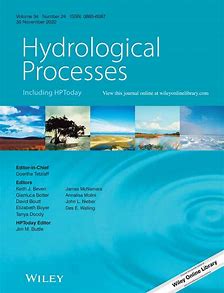- Topic:Water and matter cycles
Combined Surface-Subsurface Stream Restoration Structures Can Optimize Hyporheic Attenuation of Stream Water Contaminants
A numerical model was used to evaluate engineered stream restoration structures and how to maximise their impact on hyporheic contaminant attenuation. Combined surface-subsurface structures were able to simultaneously increase hyporheic fluxes and transit times, providing conditions for contaminant attenuation that were many times more effective than surface or subsurface structures alone.
Improved understanding of vegetation dynamics and wetland ecohydrology via monthly UAV-based classification
The authors conducted monthly UAV flights for 2 years in a riparian wetland in Germany. Such multi-flight-based classification outperformed single-flight-based ones, providing a picture of vegetation community evolution. Apart from contributing to an evidence base for wetland management, such multi-flight UAV vegetation mapping could provide fundamental insights into their landscape ecohydrology.
Synoptic water isotope surveys to understand the hydrology of large intensively managed catchments
Using seasonal, large scale synoptic sampling of stable water isotopes and tritium along the Spree allowed to assess water cycling, storage and losses. The Spree is heavily regulated and drought-sensitive due to high evapotranspiration losses. Such insights are important to adjust water management strategies.
Quantifying changes and trends of NO3 concentrations and concentration-discharge relationships in a complex, heavily managed, drought-sensitive river system
Long-term stream nitrate nitrogen concentrations and concentration-discharge were investigated along the Spree revealing significant heterogeneity in both variables. The upstream parts and winter seasons showed the most serious pollution. Concentrations and relationships are also likely to respond strongly to future droughts, leading to challenges for future land and water management.
Moving Bedforms Control CO2 Production and Distribution in Sandy River Sediments
The study investigated the impact of streamwater flow velocities and the resulting bedform migration on the CO2 production in streambeds. State-of-the-art 2-dimensional imaging techniques reveal the CO2 distribution in the streambed, an increasing CO2 production in the upper sediment and a decreasing hydrological exchange with deeper sediment layers, with increasing flow velocities.
The unexpected long period of elevated CH4 emissions from an inundated fen meadow ended only with the occurrence of cattail (Typha latifolia)
The authors present 14 years of CH4 flux measurements following rewetting of a formerly long-term drained peatland. During the study, significant differences in CH4 emissions occurred. These differences overlapped with stages of ecosystem transition from a cultivated grassland to a polytrophic lake dominated by emergent helophytes, but could also be additionally explained by other variables.
Anaerobic duration predicts biogeochemical consequences of oxygen depletion in lakes
A team from TU Bergakademie Freiberg and IGB has developed an easy-to-use method to estimate the consequences of oxygen depletion in the deep water of lakes. Monitoring data from L. Arendsee and L. Stechlin, a.o., were used to model the spatiotemporal extent of anoxia. The novel tool has the potential to predict the ecological consequences of increasing anoxia in lakes due to climate warming.
Enhancing urban runoff modelling using water stable isotopes and ages in complex catchments
Hydrological and water stable isotope datasets within a modelling framework were utilized to evaluate the water flow paths and ages in the heavily urbanized Panke catchment in Berlin. Groundwater was the primary flow component in reaches with less urbanisation. Wastewater effluent dominated the mid-reaches with direct storm runoff and shallow subsurface contributions in the urbanized reaches.
Integrating urban water fluxes and moving beyond impervious surface cover: a review
This review paper by international female experts on urban hydrology identifies gaps in our understanding of how water flows through built landscapes. It focuses on key topics within urban hydrology related to water quantity, incl. runoff and streamflow generation, soils and soil water, groundwater, vegetation, and climate; describes challenges and opportunities in the field of urban hydrology.
Using stable water isotopes to understand ecohydrological partitioning under contrasting land uses in a drought-sensitive rural, lowland catchment
To analyse the influence of vegetation on water partitioning under land management strategies, the authors used stable water isotopes with contrasting land covers and soil types in the Demnitzer Millcreek. The study underlined the need for long-term observations of land use changes and drought-sensitive vegetation to evolve a drought resilient land management considering time lags.







